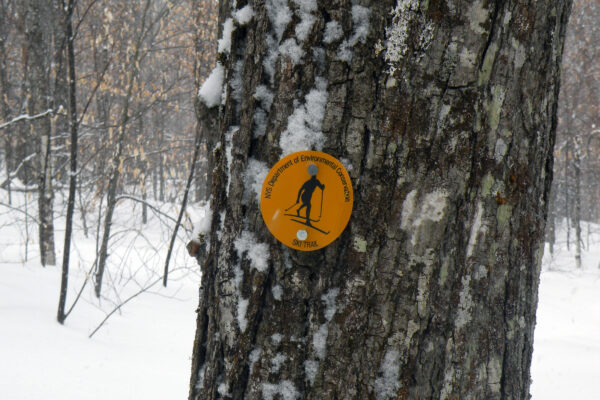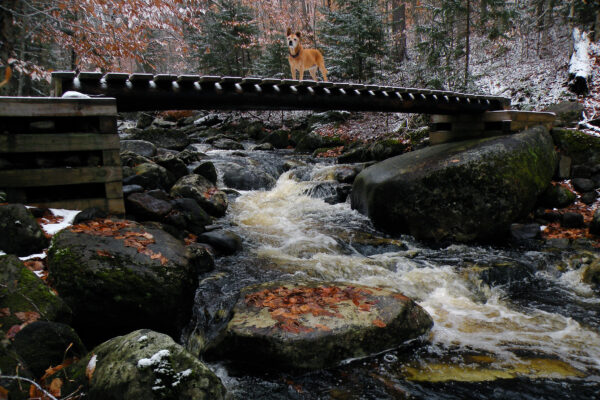Part 3 of 4
Editor’s Note: The following is Part 3 of a previously-unpublished essay written in 2003 by the late Barbara McMartin (1931-2005). In her original vision, this was to be published as a pamphlet with the working title “A Short History of Adirondack Trail Building,” part historical survey and part advocacy. No such pamphlet was ever published, and her 7300-word draft has been aging in my email folders ever since. McMartin was an outspoken advocate for trails, and her response to crowded and “overused” trails was that more trails were needed to satisfy public demand. This “Short History” attempts to defend that position by arguing New York State has never developed a master plan for hiking trails, and that the hiking trail network as it existed during her lifetime happened more or less by historical accident. Although 18 years have passed since she drafted these words, and much trail building has indeed occurred that would’ve pleased McMartin, it still seems we are debating many of the same topics that occupied much of her career. Thus there is a timeliness in posthumously publishing one of her final essays now. –Bill Ingersoll
Part of a series on the history of Adirondack trails:
Part 1: A Short History of Adirondack Trail Building
Part 2: Trails in the Mountain Pleasure Grounds
Part 3: An Advocate for Trails
Part 4: So Much Work to Be Done
Here this account takes on a new perspective, because I view what happened during the past quarter century as one who was actively involved. In the early 70s I completed my graduate work, started hiking again, and became an advocate for trails. As an advocate for dispersing hikers throughout the Park, I was frustrated from the start in ways I never expected.
I was appointed to the old High Peaks Advisory Committee[1], which evolved into the Forest Preserve Advisory Committee, because Commissioner Henry Diamond heard me complaining about the concentration of trails in the High Peaks, the lack of trails in the rest of the park, and the fact that back then snowmobile trails were not designed for hiking because they often crossed wet areas without bridges or corduroy and because small trees cleared from snowmobile trails were chopped off at about six inches high — tall enough to trip the hiker and make snowmobile-multiple use trails dangerous for hikers.
I talked about diverting hikers from the High Peaks until I was blue in the face. In 1977, with Erwin Miller, I proposed creating three marked footpaths, each different, each to show the variety of ways we could improve access to the Forest Preserve. We actually got a team of rangers and staff from Albany to look at the three proposals; one of the older rangers who accompanied us said he had to go out and buy a pair of hiking shoes for the trip — he had never owned a pair!
I was introduced to two of the trails to small mountains by Lawrence King, an avid snowshoer from Schenectady who pioneered routes to their cliff-top summits. We flagged a trail up and over Good Luck Mountain for a wonderful view from the cliffs. That trail connected two snowmobile trails and made good hiking use of them[2].
The second mountain, Moose, by the Sacandaga Campground, also had cliffs with views, but after I had inventoried the trees, ferns, and wild flowers along the proposed route, I concluded it would make a spectacular nature trail[3].
The third was a long, level route along an old road to the headwaters of one of the streams that flows into the West Branch of the Sacandaga[4]. Besides providing a great walk through mature forest, a trail here had the potential to connect with the Northville-Placid Trail at Silver Lake, bringing a second trail to otherwise trailless Silver Lake Wilderness. Needless to say, none of these trails ever materialized.
The struggles emerged on all fronts. I had written my first guidebook, published by ADK[5], with more underway, though I originally decided I would stop with southern Adirondack regions. My guides would all be based on a model of incorporating the natural and human history of each section as a way of creating interest outside the High Peaks. I was influenced by Dr. Orra Phelps and her guidebook style. The club decided to produce a series based on their High Peaks model, which does not work as well in the rest of the park. I call it the “where you put your feet guides,” not the “where you take your head guides,” which I favor. I found another publisher and ended up covering the whole Park, even though I had vowed never to climb Mt. Marcy.
Resistance, Opposition, and Bureaucratic Delays
The State Land Master Plan (SLMP), mandated by the Adirondack Park Agency Act, was designed to offer DEC guidelines for managing the Adirondack Forest Preserve. It has not proven a substitute for planning and in fact has done almost nothing to promote recreation. The guidelines for Wilderness areas are largely prohibitive, focusing on eliminating nonconformance and dealing with overuse. They seem to have been written from the perspective of the problems associated with the High Peaks. Guidelines for Wild Forest do little to point out where and what recreation ought to take place in those areas; they are anything but fleshed out and inspiring. The SLMP projects a great sense of preserving the forests and discouraging use in Wilderness areas and little regard for enhancing recreation. Hiking trails are permitted, but there is no hint of their value for the public.
All through the late seventies and the eighties, those of us who advocated for new trails kept hearing that there could be no new trails without Unit Management Plans, plans mandated by the SLMP. Each plan was expected to take a close look at the resources in an area, its management problems, and make recommendations for future management. In Region 5 we got very few completed plans. And here, ADK’s input hurt again. ADK’s policy against new trails in Wilderness areas was a major reason that new trail proposals were not a part of plan for the Siamese Ponds area, one of the first plans to be written. The Siamese Ponds area is, like the Silver Lake area, a low level wilderness with a predominantly mixed hardwood cover, scattered vistas, few trails, and a remarkably resilient forest.
Unit Management Plans have called for relatively few new trails; the main exception is Independence River Wild Forest where a very successful and popular network of horse trails had been developed. The completed plans, of which there are all too few, have called for a few new hiking trails. A new trail to a mountain with a view that lies west of Nobleboro will be built in the southern part of the Black River Wild Forest as a result of that completed plan[6].
In the early 1990s, Bob Bendick, as Deputy Commissioner, recognized the department’s planning failures, in particular in relation to trails, access, and information. He tried to use Federal funds to remedy the situation even though the funds limited what could be done. Thus he started yet another planning process, the development of a “Use and Information Plan.” Unfortunately, the study of use patterns is still incomplete, the proposals for new trails are not yet public, and what little funding that has materialized has been used to develop a map of park-wide recreation opportunities — sort of like putting the cart before the horse—because of the imbalance of opportunities park-wide. The Use and Information Plan is long on information and, so far, short on developing new patterns of use.
An even bigger problem is that, when federal money was available to fund, through ADK, a privately-created Adirondack Non-Motorized Recreation Plan, the plan has not surfaced in public discussions. The department’s natural resources staff had been so depleted by cut-backs that there was no one to evaluate and implement the plan’s recommendations.

Calls for a North Country National Scenic Trail (NCNST) to traverse the Adirondacks originated in the 1968 Trails System Act and they are still being discussed. They have met with resistance, mostly because of opposition to Federal involvement in the Park and concern that the original congressional route would loop north through the High Peaks and back down to the terminus at Crown Point. There have also been worries about overuse of the N-P Trail or other existing trails if they were to become part of the NCNST.
A few years ago, a meeting hosted by DEC and the National Park Service outlined nine potential routes for eastern New York State. The one that DEC found most acceptable traversed the southern Adirondacks. At the request of DEC I outlined a southern route, or rather a route with alternatives that would take it through either Wild Forest or Wilderness areas. ADK committees have discussed a cross-Park hiking trail. Opposition to new routes in Wilderness Areas may yet call for putting any east-west route in the southern Adirondacks through mostly Wild Forest areas, but that essentially it would do the most good, creating loops that combine hiking trails with multiple use trails[7].
ENDNOTES
[1] This is a reference to the first of three citizen advisory committees to focus on the management of the High Peaks Wilderness. A second group formed briefly in the 1990s, and the most recent was the High Peaks Advisory Group, which released a report in 2021.
[2] A portion of this trail is now marked as an official (and popular) trail.
[3] A proposal to create this trail was included in a draft management plan for the Wilcox Lake Wild Forest… which has been left uncompleted by DEC for many years.
[4] This trail exists as an unmarked footpath. It is reasonably well maintained for its first few miles but eventually grows faint – to the point where it has effectively been lost to nature prior to reaching its traditional destination.
[5] ADK is the standard shorthand for the Adirondack Mountain Club. McMartin published her first guidebook, Walks and Waterways, in 1974.
[6] Actually, the trail to Ledge Mountain in Wilmurt was completed by the time this essay was written.
[7] An approved route for the North Country Trail was selected in 2014, nine years after McMartin’s death, although she doubtlessly would’ve been disappointed with some of the decisions. Primarily, the route follows existing trails as much as possible, with only a few new links to convert these local segments into a continuous route. The NCNST can be followed across the width of the Siamese Ponds Wilderness and some adjacent areas.



